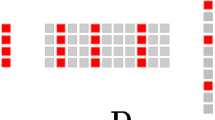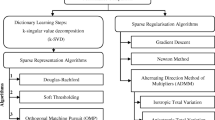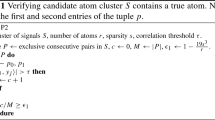Abstract
This paper illustrates a novel method for designing redundant dictionary from Chebyshev polynomials for sparse coding. Having an overcomplete dictionary in \({{\mathbb R}^{d \times N}:d < N}\) from N, orthogonal functions need to sample d times from orthogonal intervals. It is proved (“Appendix B”) that uniform distribution is not optimal for sampling. Experiments show that using non-uniform measures for dividing orthogonal intervals has some advantages in making incoherent dictionary with a mutual coherence closer to equiangular tight frames, which is appropriate for sparse approximation methods. In this paper, we first describe the dictionary design problem, then modify this design with any kind of distribution, and define an objective function respect to its parameters. Because of the abundant extremums in this objective function, genetic algorithm is used to find the best parameters. Experimental results show that generalized extreme value distribution has better performance among others. This type of dictionary design improves the performance of sparse approximation and image denoising via redundant dictionary. The advantages of this method of designing overcomplete dictionaries are going to be compared with uniform ones in sparse approximation areas.
Similar content being viewed by others
Abbreviations
- ETF:
-
Equiangular tight frame
- GEVD:
-
Generalized extreme value distribution
- OMP:
-
Orthogonal matching pursuit
- GA:
-
Genetic algorithm
- PSNR:
-
Peak signal-to-noise ratio
- D d × N :
-
General overcomplete dictionary of size d × N (d < N)
- μ (D d × N ):
-
Mutual coherence of D d × N
- T n (t):
-
Chebyshev polynomials
- \({D_{\mathcal C}}\) :
-
Overcomplete dictionary from T n (t)
- \({G_{\mathcal C}}\) :
-
Gram matrix of \({D_{\mathcal C}}\)
- \({{\mathcal G}_G}\) :
-
Gram matrix of ETFs
- μ (G d × N ):
-
Mutual coherence of ETF
- Θ:
-
Sampling distribution
- θ p :
-
pth parameter of Θ
- s u (n):
-
Uniform sampler
- s nu (n):
-
Non-uniform sampler
- D u :
-
Overcomplete dictionary with uniform distribution of orthogonal function
- μ u :
-
Mutual coherence of uniform overcomplete dictionary
- μ nu :
-
Mutual coherence of non-uniform overcomplete dictionary
- μ :
-
Mean value
- σ :
-
Standard deviations
- k :
-
Shape parameter in GEVD
References
Mallat S., Zhang Z.: Matching pursuits with time frequency dictionaries. In: IEEE Trans. Signal Process. 41(12), 3397–3415 (1993)
Aharon M., Elad M., Bruckstein A.M.: On the uniqueness of overcomplete dictionaries, and a practical way to retrieve them. J. Linear Algebra Appl. 416, 48–67 (2006)
Davis, G.: Adaptive nonlinear approximations, Ph.D. dissertation, New York University, New York, NY (1994)
Gharavi-Alkhansari, M., Huang, T.S.: A fast orthogonal matching pursuit algorithm. In: IEEE Proceedings of the International Conference on Acoustics Speech and Signal Processing, Seattle, USA, pp. 1389–1392, May 1998
Temlyakov V.N.: Weak greedy algorithms. Adv. Comput. Math. 12(2–3), 213–227 (2000)
Chen S., Billings S.A., Luo W.: Orthogonal least squares methods and their application to non-linear system identification. Int. J. Control 50(5), 1873–1896 (1989)
Blumensath T., Davies M.: Gradient pursuits. In: IEEE Trans. Signal Process. 56(6), 2370–2382 (2008)
Gorodnitsky I.F., Rao B.D.: Sparse signal reconstruction from limited data using FOCUSS: a re-weighted norm minimization algorithm. In: IEEE Trans. on Signal Process. 45(3), 600–616 (1997)
Chen S., Donoho D., Saunders M.: Atomic decomposition by basis pursuit. SIAM J. Sci. Comput. 43(1), 129–159 (2001)
Rubinstein R., Bruckstein A.M., Elad M.: Dictionaries for sparse representation modeling. In: IEEE Proc. Special Issue Appl. Sparse Represent. Compress. Sens. 98(6), 1045–1057 (2010)
Mallat, S.: A Wavelet Tour of Signal Processing, 3rd edn, pp. 263–483. Academic, New York, NY. Ch. 7 and ch.8 (2009)
Candès, E.J., Donoho, D.L.: Curvelets, a surprisingly effective non adaptive representation for objects with edges. In: Curve and Surface Fitting: Saint-Malo, pp. 105–120. Vanderbilt University Press, Nashville, TN (1999)
Do M.N., Vetterli M.: The contourlet transform: an efficient directional multiresolution image representation. In: IEEE Trans. Image Process. 14(12), 2091–2106 (2005)
LePennec E., Mallat S.: Sparse geometric image representations with bandelets. In: IEEE Trans. Image Process. 14(4), 423–438 (2005)
Engan, K., Aase, S.O., Husoy, J.H.: Method of optimal directions for frame design. In: Proceedings of the IEEE International Conference on Acoustics, Speech, and Signal Processing (ICASSP), vol. 5, pp. 2443–2446 (1999)
Aharon M., Elad M., Bruckstein A.M.: The K-SVD: an algorithm for designing of overcomplete dictionaries for sparse representation. In: IEEE Trans. Signal Process. 54(11), 4311–4322 (2006)
Yaghoobi M., Blumensath T., Davies M.: Parametric dictionary design for sparse coding. In: IEEE Trans. Signal Process. 57(12), 4800–4810 (2009)
Rubinstein R., Zibulevsky M., Elad M.: Double sparsity: learning sparse dictionaries for sparse signal approximation. In: IEEE Trans. Signal Process. 58(3), 1553–1564 (2010)
Aharon M., Elad M., Bruckstein A.M.: The K-SVD: an algorithm for designing of overcomplete dictionaries for sparse representation. In: IEEE Trans. Signal Process. 54(11), 4311–4322 (2006)
Strohmer T., Heath R.: Grassmannian frames with applications to coding and communication. Appl. Comput. Harmon. Anal. 14(3), 257–275 (2003)
Tropp J., Dhillon I., Heath R. Jr, Strohmer T.: Designing structural tight frames via an alternating projection method. In: IEEE Trans. Inf. Theory 51(1), 188–209 (2005)
Ahmed N., Roo K.R.: Orthogonal Transforms for Digital Signal Processing, pp. 170. Springer, Berlin (1975)
Nakagaki K., Mukundan R.: A fast 4 × 4 forward discrete Tchebichef transform algorithm. In: IEEE Signal Process. Lett. 14(10), 684–687 (2007)
Lee P.A., Mukundan R., Ong S.H.: Image analysis by Tchebichef moments. In: IEEE Trans. Image Process. 10(9), 1357–1364 (2001)
Kotz S., Nadarajah S.: Extreme Value Distributions: Theory and Application. Imperial College Press, London (2000)
Nikiforov A.V., Suslov S.K., Uvarov V.B.: Classical Orthogonal Polynomials of a Discrete Variable. Springer, Berlin (1991)
Goldberg D.E.: Genetic Algorithms in Search, Optimization and Machine learning. Addison Wesley, Boston, MA (1989)
Bury, K.: Statistical Distributions in Engineering, pp. 120–225. Cambridge University Press, Cambridge. Ch. 10–13 (1999)
Bruckstein A.M., Donoho D.L., Elad M.: From sparse solutions of systems of equations to sparse modeling of signals and images. SIAM Rev. 51(1), 34–81 (2009)
Gribonval, R., Schnass, K.: Some recovery conditions for basis learning by L1-minimization. In: Proceedings of the International Symposium on Communications, Control, Signal Processing (ISCCSP), Malta, 12–14 March, pp. 768–773 (2008)
Tropp J.: Greed is good: algorithmic results for sparse approximation. In: IEEE Trans. Inf. Theory 50(10), 2231–2242 (2004)
Gribonval R., Vandergheynst P.: On the exponential convergence of matching pursuits in quasi-incoherent dictionaries. In: IEEE Trans. Inf. Theory 52(1), 255–261 (2006)
Elad, M.: Sparse and Redundant Representations: From Theory to Applications in Signal and Image Processing. Springer, Heidelberg (2010). http://www.springer.com/mathematics/analysis/book/978-1-4419-7010-7
Elad M., Aharon M.: Image Denoising via Sparse and Redundant representations over Learned Dictionaries. In: IEEE Trans. Image Process. 15(12), 3736–3745 (2006)
Author information
Authors and Affiliations
Corresponding author
Rights and permissions
About this article
Cite this article
Nozari, H., Karami, M.R. Design redundant Chebyshev dictionary with generalized extreme value distribution for sparse approximation and image denoising. SIViP 8, 327–338 (2014). https://doi.org/10.1007/s11760-012-0295-3
Received:
Revised:
Accepted:
Published:
Issue Date:
DOI: https://doi.org/10.1007/s11760-012-0295-3




